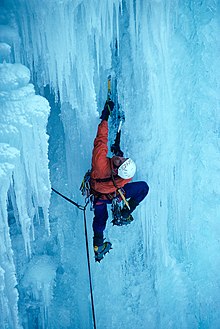
Back تسلق الجليد Arabic आइस क्लाइम्बिंग BH Escalada en gel Catalan Isklatring Danish Eisklettern German Αναρρίχηση σε πάγο Greek Escalada en hielo Spanish Izotz-eskalada EU یخنوردی FA Jääkiipeily Finnish

| Part of a series on |
| Climbing |
|---|
| Lists |
| Types of rock climbing |
| Types of mountaineering |
| Other types |
| Key actions |
| Key terms |
Ice climbing is a climbing discipline that involves ascending routes consisting entirely of frozen water. To ascend, the ice climber uses specialist equipment, particularly double ice axes (or the more modern ice tools) and rigid crampons. To protect the route, the ice climber uses steel ice screws that require skill to employ safely and rely on the ice holding firm in any fall. Ice climbing routes can vary significantly by type, and include seasonally frozen waterfalls, high permanently frozen alpine couloirs, and large hanging icicles.
From the 1970s, ice climbing developed as a standalone skill from alpine climbing (where ice climbing skills are used on ice and snow). Ice climbing grades peak at WI6 to WI7 as ice tends to hang vertically at its most severe. WI7 is very rare and usually attributed to overhanging ice with serious risk issues (i.e. unstable ice, little protection, and a risk of death). Mixed climbing has pushed the technical difficulty of ice climbing routes by crossing bare rock overhangs and roofs (using ice tools on bare rock is called dry-tooling).
Since 2002, the UIAA have regulated competition ice climbing, which is offered in a lead climbing format on an artificial bolted wall that employs dry-tooling techniques (e.g. stein pulls and figure-four moves), and in a speed climbing format that uses a standardized wall of real ice. Since 2010, ice climbers at Helmcken Falls in Canada have been able to use the unique characteristics of the waterfall to create new severely overhanging bolted ice climbing routes, that are graded up to WI13, and are the hardest technical[a] ice climbs in the world.
Cite error: There are <ref group=lower-alpha> tags or {{efn}} templates on this page, but the references will not show without a {{reflist|group=lower-alpha}} template or {{notelist}} template (see the help page).